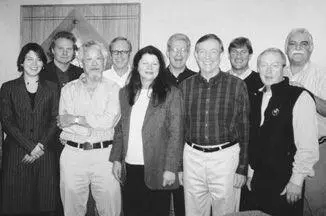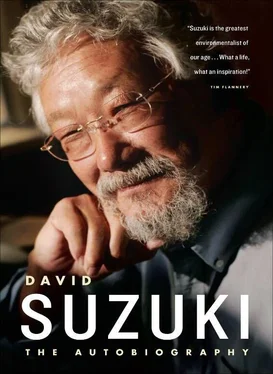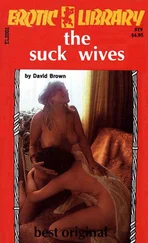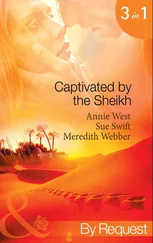
The Board of the David Suzuki Foundation. Left to right : Severn, Wade Davis, me, Mike Robinson, Tara, Peter Steele, Ray Anderson, Stephen Bronfman, Jim Hoggan, and Jim Fulton. (Absent: Stephanie Green and Miles Richardson.)
I also presented the report to the Federation of Canadian Municipalities in Ottawa to a very positive reception. The Australian Conservation Foundation is now writing an Aussie version of SWAG.
In November 2005, John deCuevas, a colleague of Tara's when she taught at Harvard, invited a group of thirty-five funders, scientists, environmentalists, and activists to meet us for a dinner and then spend the following day in discussion at Harvard's Faculty Club. I presented “Sustainability Within A Generation,” which was embraced with enthusiasm. The group recommended that the DSF document be Americanized, and two researchers have been hired to work on this. The group wants to put together a blue-ribbon panel of scientists, economists, athletes, celebrities, and politicians to be ambassadors for SWAG.
“Sustainability Within A Generation” has been a galvanizing and unifying focus within the foundation because all of our projects are tied to the goal of sustainability within its 2030 time frame.
WHEN THE RADIO SERIES It's a Matter of Survival was broadcast in 1988, I was overwhelmed by the speed with which the planet was undergoing human-caused degradation. Since the foundation opened its doors, the signs of danger have been rising.
Human beings are not specially gifted in speed, strength, size, or sensory acuity compared with the other animals we evolved with on the African plains. Our great evolutionary feature was our brain, which conferred memory, curiosity, and inventiveness that more than compensated for our lack of physical attributes. Foresight, the ability to look ahead and recognize both dangers and opportunities, guided us into the future. That was what got us to this moment in time, when we are the most numerous, powerful, and demanding mammal on Earth.
We have been repeatedly warned that we are on a dangerous path. We must not turn our backs on the core survival strategy of our species by subordinating ecological concerns to the demands of the economy, political feasibility, and personal ambition.
The battle to save Mother Earth remains urgent and must continue.
THIRTEEN
RIO AND THE EARTH SUMMIT
IN 1991, SOON AFTER we had established the David Suzuki Foundation, we heard that the Earth Summit was to be held in Rio de Janeiro in June 1992. The American zoologist Rachel Carson in 1962 had published her ground-breaking book Silent Spring , about the unexpected consequences of pesticides, and the environmental movement had grown spectacularly through the 1970s and '80s.
The Earth Summit was meant to signal a profound shift, the realization that henceforth humankind couldn't make important political, social, and economic decisions without considering the environmental consequences. But by the time of the meetings, environmental concerns were already giving way to economic priorities.
The period between Silent Spring and Rio reflected the evolution of a remarkable grassroots movement. Greenpeace had been born in 1970 in Vancouver as a result of protest against an American plan to test nuclear weapons underground on Amchitka Island in the Aleutian Islands, off the Alaska Peninsula.
In 1962, there wasn't a single department or ministry of the environment on the planet. Carson's book put the word “environment” on everyone's lips, and the movement had grown so explosively that by 1972 the United Nations was persuaded by Canadian businessman and international environmentalist Maurice Strong to hold a major conference on the environment in Stockholm. The American scientists and educators Paul Ehrlich, Margaret Mead, and Barry Commoner were there, as was the English economist and conservationalist Barbara Ward, along with Greenpeace and thousands of environmentalists concerned about species extinction, pollution, and disappearing habitat.
The United Nations Environment Program was established as an outcome of the Stockholm meetings, and environmentalists took up causes from whales and seals to polluted air and vanishing forests and rivers. The spectacular postwar economic growth had come at a cost that people recognized only after Carson's warning shot. Technology and human activity have consequences for our surroundings, and we had ignored them for too long.
For most of our species' existence, we have been profoundly local and tribal, spending most of our individual lives within a few tens of square miles and coming into contact with perhaps a couple of hundred others in a lifetime. But now we were emerging as a global force. Now we had to consider the collective impact of all of humanity, and it was a difficult perspective to grasp and accept.
When Tara and I had visited the village of Aucre deep in the Amazon rain forest in 1989, we had left a small plastic bag of garbage in our hut, assuming it would be buried after we left. When I returned a decade later, that bag was still there. Throughout their existence, the Kaiapo had lived with materials that were totally biodegradable and so could be left where they were or tossed into the forest to eventually decompose. When plastics and metals began to appear in the Amazon as the Kaiapo made contact with the outside world, those materials were strewn around just like the banana skins of old.
In the twentieth century, human beings had become so numerous and our technological prowess so powerful that we were affecting the biophysical features of the planet on a massive scale. Yet we still thought as local animals. It was almost impossible for the average person to grasp the idea of millions of acres of forest being destroyed, billions of tons of topsoil being lost, toxic pollution of the entire atmosphere, and a massive spasm of extinction. The environmental movement had to come up with catchy ways of representing the bigger picture so people could relate to it — the Amazon as the “lungs of the planet,” cute and cuddly baby seals, charismatic animals like whales or gorillas.
The movement grew as local communities began to grasp the consequences of using air, water, and soil as toxic dumps and belatedly recognized the value of wilderness and of other species. By the late '80s, grassroots concern had pushed the environment to the top of the list of public concerns to such an extent that Margaret Thatcher, the ultra-right-wing Conservative prime minister of Britain, was filmed picking up litter and declaring to the camera, “I'm a greenie too.” In Canada, newly reelected Progressive Conservative prime minister Brian Mulroney demonstrated a sudden commitment to the environment by appointing his brightest star, the mesmerizing political novice Lucien Bouchard, as minister of the environment and raising the portfolio to the inner cabinet.
In the United States in 1988, Republican political candidate George Bush Sr. promised that, if elected, he would be “an environmental president.” Australia's Labor government was led by Bob Hawke and then by Paul Keating during this period, neither of whom had any record of interest in the environment. But the public was concerned, and Keating was forced to appoint as minister a champion of the environment, Ros Kelly, whom I met and admired over the years.
As their records in office demonstrated, it was public concern about the environment that generated the declared environmental commitments by politicians, not any deeply felt understanding of why the issue was important. When economic difficulties set in, the environment disappeared as a high priority and the environmental movement was forced to struggle to keep matters on the political agenda. To the jaded media, the environment was an old story. Indeed, some revisionists, such as the American writer Gregg Easterbrook, the Danish political scientist Bjørn Lomborg, and former Greenpeace president Patrick Moore, began to argue that the environmental movement was beating a dead horse, that it had been so successful that it was time to move on to other issues such as the economy.
Читать дальше



![David Jagusson - Devot & Anal [Hardcore BDSM]](/books/485905/david-jagusson-devot-anal-hardcore-bdsm-thumb.webp)









